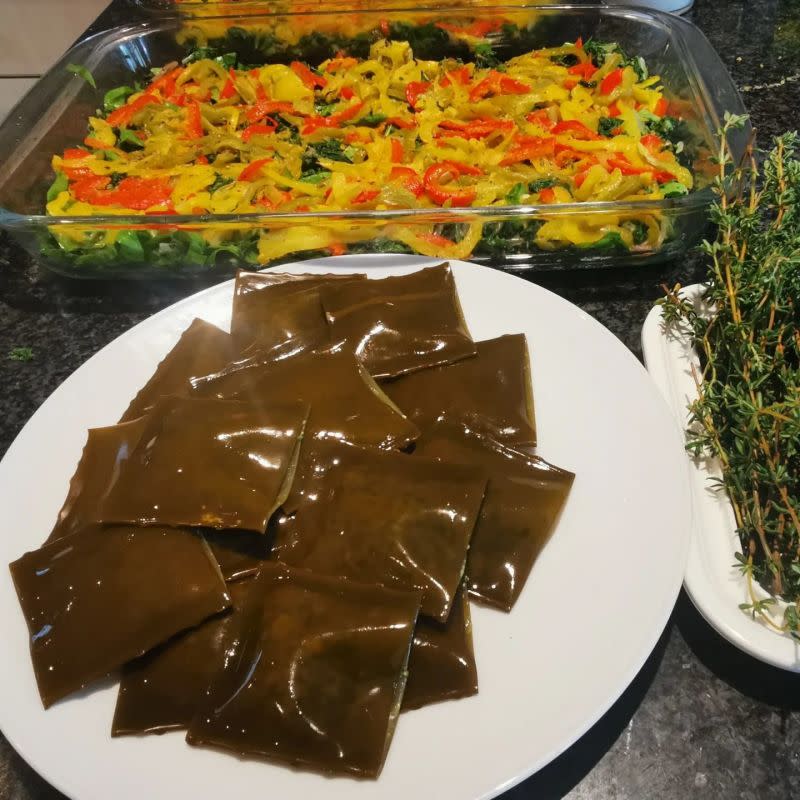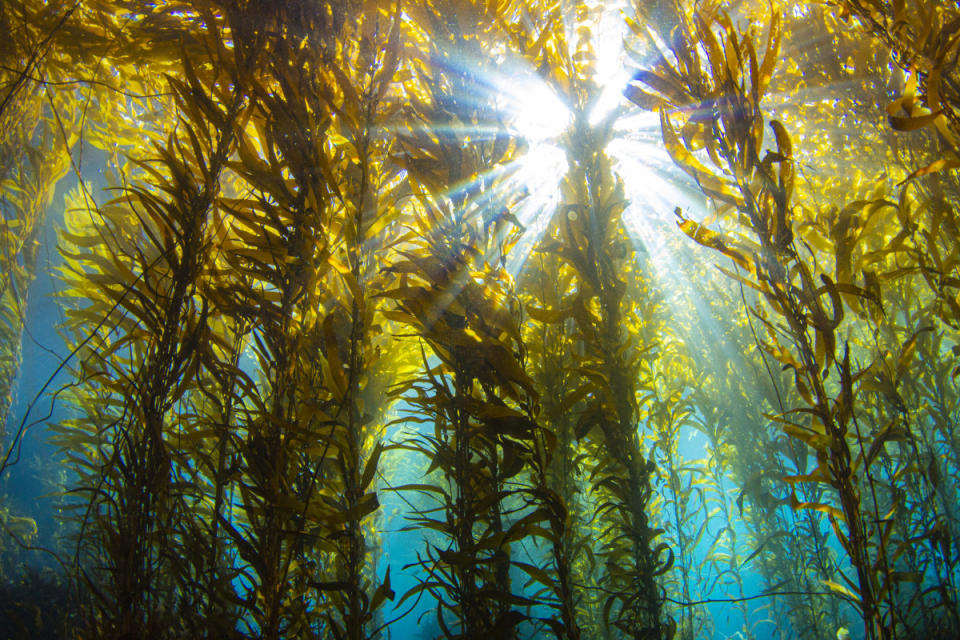Can Seaweed Curb World Hunger and Climate Change? How Kelp Benefits the Future of Food
It’s a typical summer afternoon in Kommetjie, a coastal community about 25 miles south of Cape Town, South Africa’s capital. The sun dances atop the surf, and a cool breeze blows down off the mountainous spine of this narrow peninsula, which terminates in the Cape of Good Hope. I’m walking alone on a remote section of beach when a man in a wetsuit emerges from the water to greet me, clutching a giant mass of seaweed in his hand.
“Lovely day for it,” he says, with seawater beading down his weathered face.
This is Phil Mansergh. He’s helping to change the way the world eats. The accomplished chef left a lucrative gig in the city in 2018 to open The Kelp Shack along this quiet stretch of shore. True to its name, this is a cozy, seaside shanty specializing in seaweed preparations.
What Is Kelp?
The difference between kelp and seaweed is kelp describes the largest subgroup of seaweed and encompasses a wide range of large algae found along shallow edges of the ocean in underwater forests. Sea kelp can be brown, olive, or dark green in color and thrive in nutrient-dense waters at temperatures between 43 to 57 degrees Fahrenheit. In optimal conditions, some species can grow by as much as 1.5 feet in a single day.
If you're used to seeing seaweed salads and kelp with a bright green color, that's because when seaweeds are boiling or blanched, most of the pigments dissolve, leaving behind the bright green chlorophyll.
Kelp Benefits
It’s difficult to overstate just how beneficial this sort of vegetation is for our future. In fact, seaweed might just save it. A 2023 study from the Friedman School of Nutrition Science and Policy at Tufts University shows that seaweed farming can tackle world hunger and malnutrition while also slowing climate change.
1. Superfood Source of Nutrients
“Kelp is one of the most nutritious plants on the planet,” says Mansergh as he begins prepping his kitchen for the daily lunch service. For the pedantic sorts: The organism is technically not a plant, but a stramenopile.
Kelp offers 25 calories per two-ounce serving alongside 20 distinct vitamins, minerals, and antioxidants including vitamin K, vitamin A, Vitamin B12, iron, and magnesium. The powerhouse also packs dietary fibers, omega-3 fatty acids, and essential amino acids.
“It’s naturally high in iodine and has 10 times the calcium value of milk," Mansergh adds.
It may help promote cardiovascular health and even reduce fat absorption in the stomach.
2. Sustainable Food Source
"We're currently exhausting our soil resources on land by over-farming as demand increases for more food. But, unlike land plants, which need to be ‘fed,' kelp gets its food from the sun and nutrients in the ocean.”
Kelp's proliferation in the ocean makes waters naturally less acidic, according to an on-site, interdisciplinary analysis of giant kelp in Monterey Bay off the coast of California, published in the journal JGR Oceans.
Moreover, these underwater jungles are many times more effective at absorbing carbon than trees on land. In fact, up to 20 times more carbon per acre than land forests, according to an article from Harvard University.

Courtesy Image
3. Versatile Culinary Uses
Kelp can also be rendered into a surprising variety of end products. Today, Mansergh’s menu consists of a kelp burger, which he’s searing up on an outdoor grill, and a kelp ravioli stuffed with its own minced fronds. The pasta alternative is his favorite dish, one that he's dubbed “Mermaid’s Purse.”
Last year, Mansergh released a line of bottled, pickled, and fermented kelp products, including chutney and sauerkraut so even those in the surrounding area who can’t make it to his shack are still able to sample some of his creations. His ingenuity with the maritime flora is being well-received throughout the Western Cape of South Africa. But he's merely one player at the vanguard of a global movement.
Half a world away, Øistein Nilsen is introducing kelp-based cuisine to cruise-goers, as the culinary director for Hurtigruten Norway. The cruise liner was originally established by the Norwegian government in 1893 to facilitate transport and communication along the country’s rugged coast. Today, it doubles as a comfortable floating hotel ideal for sightseeing.
“We now use [kelp] in many dishes aboard the main restaurant of our Coastal Express ships,” Nilsen explains. “In fact, it’s an element in almost every dish on our a la carte menus. It can be used raw, dried, powdered, and as a supplement. It also has an amazing umami taste.”

Getty Images
As he's keen to point out, keeping kelp forests healthy can have a much broader impact than just enabling a more adventurous meal. They’re home to a huge swath of sea life, including otters, lions, and even some species of whales.
The issue is overfishing through the second half of the 20th century disrupted the balance of kelp forests along the Norwegian coast, removing predators and allowing plant-eating populations to explode and, in turn, overeat the kelp.
Much of that waterway now exists as an underwater desert. So, in late 2022, Hurtigruten started a collaboration with Lyngen Seaweed, a sustainability focused marine agriculture operation out of Tromsø. Together they’re working to distribute new shoots of kelp—which have been cultivated in a controlled setting—throughout the rich fjords just outside the northerly city. The hope is that the project will minimize the carbon footprint along the coast while also providing some fantastic fare for Hurtigruten passengers.
And that’s just the beginning.
“As we speak, we only use [kelp] in food, but we're looking into many other uses,” Nilsen adds. “It has potential as an alternative to plastic and animal feed. It can be used for toothpastes, shampoos, and pharmaceuticals, and might even be used as an alternative energy source one day. The field of kelp innovation is quite new, and we’ve just started to see what this beautiful resource can contribute to mankind. We want to be in the forefront and help take this marvelous sea vegetable into the future.”
Down under, the Australian island of Tasmania has emerged as a hotbed for seaweed-infused cuisine. But an invasive species of wakame from Asian waters has devastated the native kelp in this part of the world. So local chefs have stumbled upon a novel solution: Put as much wakame on the menu as customers can stand. Which, it turns out, is quite a lot.
“We love seaweed,” says Vince Trim, executive chef for the eateries inside MONA, home to the country’s widest collection of avant-garde art. “It’s a truly unique and diverse ingredient. We use it in many of our dishes to impart a wonderful umami flavor, saline aromas, and incredible textures. We use it on all parts of our menu: We create crisp shards for furikake; we serve it freshly blanched in salads; we make a sticky soy and sake marmalade or even use it candied for desserts.”

Courtesy Image
With the help of Trim and his colleagues, the native kelp will one day return. Especially as awareness grows among the public about just how significant and far-reaching this specific sort of seaweed can be.
Back on the beach at Kommetjie, Mansergh is seeing the shift with his own eyes. He hasn’t even changed out of his wetsuit yet, but he’s busy getting ready for one of his private four-course kelp meals—they’ve become a hot ticket as word spreads through neighboring Cape Town. Though he’s seemingly lost in menu creation, his mind turns to something much farther from shore.
“Regenerative farming of our oceans is the next logical step,” he says. “There is definitely more interest toward eating kelp in the West, and this will encourage better practices toward keeping our oceans healthy. It will also keep us healthier. The Japanese have been consuming seaweed since at least the 8th century, and it’s been directly linked to longevity.”
Mansergh proceeds to go down the laundry list of kelp farming’s inherent virtues: supporting an abundance of sea life, sequestering carbon in the environment, sustainably transforming the cosmetics industry. It all makes the kelp burger I’m enjoying seem decidedly less meaningful—but no less delicious.

